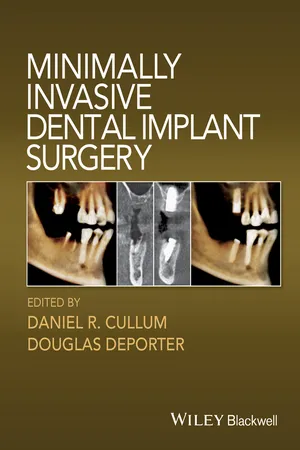CHAPTER 5
Extraction Site Management for Ridge Preservation and Implant Site Development
Barry Bartee1 & Daniel R. Cullum2
1Osteogenics Biomedical, Inc., Lubbock, TX, USA
2Private Practice, Coeur d’Alene, ID; Loma Linda University Department of OMS, Loma Linda, CA; UCLA Department of OMS, Los Angeles, CA, USA
Introduction
The treatment complications of alveolar bone loss seen after tooth extraction are well known.1, 2 In sites where dental implants are planned, even slight changes in alveolar ridge contours may affect the ability of the implant team to deliver a satisfactory implant restoration. Loss of bone may require placement of shorter or smaller diameter implants, and/or necessitate complex surgical3–5 and/or prosthodontic interventions to achieve the desired result.6–8 While bone loss at healed extraction sockets can be partially regenerated by augmentation grafting, a less invasive and more predictable approach may be to employ grafting procedures to preserve ridge anatomy during initial site healing. This chapter will discuss the rationale and sample techniques for this treatment concept. In particular, flapless grafting with “modified” Bio-Col® and the use of “open barrier” techniques without primary wound closure, using high-density (i.e. non-porous) polytetrafluoroethylene (hd-PTFE) membranes will be reviewed and discussed.
Rationale for alveolar ridge preservation
The current definition of esthetic success in implant dentistry includes a natural appearance for peri-implant soft tissues. While challenging to achieve, the ideal implant restoration should include soft tissues that have the correct proportion of keratinized gingiva and alveolar mucosa, minimal disruption of the position of the mucogingival junction, and minimal soft tissue scarring.9–13 The level of the gingival margin should be symmetrical with respect to the contralateral tooth, and soft tissues should exhibit natural color, contour, texture, and tone, including the interdental papillae being proportional with respect to adjacent and contralateral teeth. Thickness of soft tissues should be adequate to render the underlying implant and restorative margins inconspicuous. All of these soft tissue requirements are dependent on a foundation of adequate bone volume, contour, and density, not only to achieve primary implant stability, but also to provide a framework for support of soft tissues surrounding the implant.14–16 A direct correlation of soft tissue thickness to underlying bone anatomy/thickness has recently been advanced.17
When tooth loss occurs, the surrounding hard and soft tissues heal with very different kinetics. Competition occurs between the rapidly proliferating soft tissue cells and the more slowly developing bone-derived cells to fill any existing defects. In the typical extraction site, the apical two-thirds of the socket is quickly repaired with appositional bone growth from the socket walls, while the coronal one-third is filled with fibrous scar tissue. Clinically, this pattern of secondary wound healing and contraction results in a convex crestal alveolar ridge anatomy. Significant remodeling of alveolar crest and buccal cortical plate then occurs during the next 2–3 months, resulting in further loss of bone and soft tissue volume. The extent of alveolar remodeling is affected by a myriad of anatomic, cellular, biochemical, environmental, and biomechanical factors that vary greatly among individual patients. The clinical challenge is that changes experienced for an individual patient are difficult to predict. However, controlled studies of socket healing in relatively intact sockets indicate that as much as 2–4 mm loss in alveolar ridge bucco-lingual width and 1–3 mm loss in height can occur in the first 6 months.18–21 Ultimately, as much as 40–50% of alveolar width and 20–30% of height can be irreversibly lost in the first year following extraction.22 Over time, atrophy ultimately results in the thin, knife-edge ridge or total loss of the alveolus down to basal bone. Fortunately, most of these effects of tooth loss can be prevented in the short term and reduced significantly over longer periods by ridge preservation grafting and a minimally invasive surgical approach.
Frequently, patients presenting for dental implants have severely compromised alveolar ridge anatomy as a result of root fracture, endodontic treatment failure, facial trauma, or chronic destructive periodontitis. Many times the affected teeth have already been removed without consideration for the ultimate treatment plan, resulting in larger defects than would otherwise have occurred. Our goal is to have a healed site with contour preservation, avoiding hard and/or soft tissue defects that increase the challenge of reconstruction without compromised esthetics and long-term stability.
The biology of extraction socket healing
To develop effective clinical strategies to reduce the extent of alveolar ridge resorption post-extraction, it is helpful to review the process of normal extraction socket healing. While it is recognized that the minimally traumatic extraction technique helps to minimize ridge resorption, a certain amount of tissue trauma is unavoidable. With the initial incision and soft tissue flap reflection, there is disruption of the dento-gingival attachment and periosteum, while luxation of the tooth root can cause microfractures of the alveolar walls, which can stimulate bone remodeling.23 The forces needed for tooth removal (rotation, shear, tension, and compression) cause further damage to surrounding bone by disrupting its microcirculation.24
Following tooth removal, blood from the damaged vessels and bone enters the socket, and platelets are activated to aggregate and seal ruptured vessels. As platelet degranulation occurs, growth factors are released locally. A loose network of fibrin forms, entrapping blood cell...
